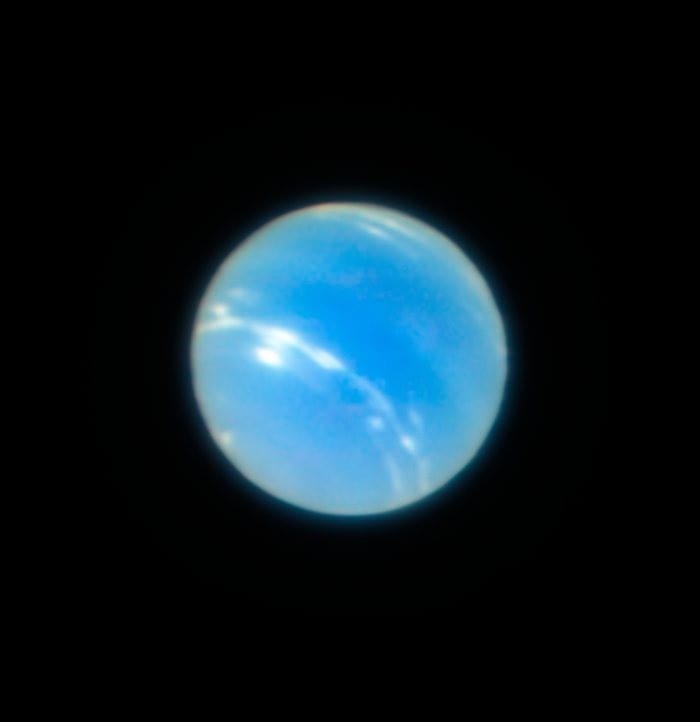
A unique new instrument at Gemini South in Chile takes the removal of atmospheric distortions (using adaptive optics technology) to a new level.
Today’s release of seven ultrasharp, large-field images from the instrument’s first science observations demonstrate its remarkable discovery potential.
Astronomers recently got their hands on Gemini Observatory’s revolutionary new adaptive optics system, called GeMS, “and the data are truly spectacular!” says Robert Blum, Deputy Director of the National Optical Astronomy Observatory with funding by the U.S. National Science Foundation. “What we have seen so far signals an incredible capability that leaps ahead of anything in space or on the ground – and it will for some time.” Blum is currently using GeMS to study the environments in and around star clusters, and his preliminary data, targeting the spectacular cluster identified as RMC 136, are among a set of seven images released today. The remaining six images –– spanning views of violent star-forming regions, to the graceful interaction of distant colliding galaxies –– only hint at the diversity of cutting-edge research that GeMS enables.
After more than a decade in development, the system, now in regular use at the Gemini South telescope in Chile, is streaming ultrasharp data to scientists around the world – providing a new level of detail in their studies of the universe. The images made public today show the scientific discovery power of GeMS (derived from the Gemini Multi-conjugate adaptive optics System), which uses a potent combination of multiple lasers and deformable mirrors to remove atmospheric distortions (blurriness) from ground-based images.
Unlike previous AO systems, GeMS uses a technique called “multi-conjugate adaptive optics,” which not only captures more of the sky in a single shot (between 10- to 20-times more area of sky imaged in each “picture”) but also forms razor-sharp images uniformly across the entire field, from top-to-bottom and edge-to-edge. This makes Gemini’s 8-meter mirror 10- to 20-times more efficient, giving astronomers the option to either expose deeper, or explore the universe more effectively with a wider range of filters, which will allow them to pick out subtle yet important structural details never seen before.
“Each image tells a story about the scientific potential of GeMS,” says Benoit Neichel who led the GeMS commissioning effort in Chile. According to Neichel, the targets were selected to demonstrate the instrument’s diverse “discovery space” while producing striking images that would make astronomers say, ”I need that!”
The first data coming from GeMS are already making waves among astronomers across the international Gemini partnership. Tim Davidge, an astronomer at Canada’s Dominion Astrophysical Observatory, with funding by the Canadian National Research Council, studies populations of stars within galaxies beyond our Milky Way. His work requires extreme resolution to see individual stars millions of light-years away. “GeMS sets the new cool in adaptive optics,” says Davidge. “It opens up all sorts of exciting science possibilities for Gemini, while also demonstrating technology that is essential for the next generation of ground-based mega-telescopes. With GeMS we are entering a radically new, and awesome, era for ground-based optical astronomy.”
The Latest Bing News on:
Adaptive optics
- iPad Air M2 vs iPad Pro M4: Power vs priceon May 15, 2024 at 9:53 am
In all honesty, the M2 in the Air is more than enough for people using the iPad as an everyday device, while the M4 is truly Pro-level hardware that should satisfy even the most demanding iPad ...
- Are there blind scuba divers? Here's the accessible way anyone can explore the ocean.on May 13, 2024 at 1:06 pm
With its intensive gear, most people wouldn’t think of scuba diving as an easily adaptive sport. However, just about anyone can explore the ocean.
- Breakthrough Method Pierces Ionosphere to Reveal Radio Universe in Stunning Clarityon May 8, 2024 at 8:21 pm
The technique isn't perfect – lines radiate around radio sources in the new image; this is because the ionosphere causes the source to appear to move around. The calibration has pinpointed the source ...
- What can AI learn about the universe?on May 3, 2024 at 9:45 am
Artificial intelligence and machine learning have become ubiquitous, with applications ranging from data analysis, cybersecurity, pharmaceutical development, music composition, and artistic renderings ...
- NEI applies artificial intelligence to OCT for retinal imagingon April 15, 2024 at 5:00 pm
Researchers at the National Eye Institute (NEI), part of the US National Institutes of Health, have applied a particular artificial intelligence approach to OCT imaging of the retina. The research, ...
- Newly found rare cells could be a missing link in color perceptionon April 15, 2024 at 12:30 pm
In a new study in the Journal of Neuroscience, researchers at the University of Rochester have used adaptive optics to identify rare retinal ganglion cells (RGCs) that could help fill in the gaps in ...
- Are these newly found rare cells a missing link in color perception?on April 14, 2024 at 5:00 pm
Scientists have long wondered how the eye’s three cone photoreceptor types work together to allow humans to perceive color. In a new study in the Journal of Neuroscience, researchers at the ...
- Adaptive opticson October 5, 2023 at 4:55 pm
The use of deformable mirrors to correct unwanted optical aberrations in real time is helping applications ranging from astronomy to biophotonics and data storage, reports Neil Savage. Adaptive ...
- Adaptive Optics in Astronomyon December 1, 2022 at 6:04 pm
Beletic, James W. Dorn, Reinhold J. Craven-Bartle, Thomas and Burke, Barry 2000. Optical Detectors For Astronomy II. Vol. 252, Issue. , p. 283.
- Benjamin D. Singer, PhDon March 6, 2022 at 4:39 am
I work on neuroimaging analysis methods such as cortical alignment, realtime fMRI correlation and classification, surface-based analysis and visualization, and model-based neural networks in multiple ...
The Latest Google Headlines on:
Adaptive optics
[google_news title=”” keyword=”Adaptive optics” num_posts=”10″ blurb_length=”0″ show_thumb=”left”]
The Latest Bing News on:
Fix the internet
- Possible Espionage Threat? US Officials Warn Of Chinese Interference With Undersea Internet Cables In Pacificon May 19, 2024 at 8:52 am
U.S. authorities have privately alerted telecom companies about the potential susceptibility of undersea internet cables in the Pacific Ocean to meddling by Chinese repair ships.
- ‘Another example of the manufacturer forcing you out of a vehicle’: Mechanic reveals looming hidden cost for Nissan driverson May 19, 2024 at 2:00 am
An auto mechanic says a Nissan transmission problem highlights a 'disgusting' auto industry practice, sparking debate.
- There's a mod to fix Gale's beard, making Baldur's Gate 3 playable at laston May 18, 2024 at 8:44 pm
Of course, the one essential Baldur's Gate 3 mod remains the one that removes the party limit, as is true of so many RPGs. But if I was going to download a second mod for my current playthrough, Gale ...
- Reason behind the comment about officer’s damaged pants in pro golfer’s arreston May 17, 2024 at 5:18 pm
“Detective Gillis’ uniform pants, valued at approximately $80 were damaged beyond repair,” the citation states. The internet wasted no time creating memes about the comment that seemed a little out of ...
- Are Cars Getting Harder to Fix?on May 17, 2024 at 7:00 am
Repairing cars is getting more expensive. But could it be possible that one simple repair now requires a $400 tool?
- Google looks intent on breaking the business of the internet, and AI won't fix iton May 16, 2024 at 10:25 am
Google suggests it will begin rolling out AI Overviews only where it sees the most benefit from it being used. Though there's nothing explicitly preventing a gradual expansion into the more of the ...
- The Finals: How to Fix Build Request Failed Erroron May 16, 2024 at 1:01 am
Adding to the frustration is the lack of a proper solution. Fortunately, the developers have acknowledged the same and are working to completely fix the Build Request Failed error in The Finals. That ...
- Working from my couch destroyed my back, neck, and posture. The internet suggested I buy this to fix it, and it actually worked.on May 15, 2024 at 2:21 am
I'm often working on my laptop and sitting on the couch much of the day, and my back and neck pain has worsened. Using the Ready Rocker has helped.
- Africa's internet vulnerability and how to fix iton May 14, 2024 at 7:58 am
A severe internet outage that has hit several African countries - the third disruption in four months - is a stark reminder of how vulnerable the service is on the continent. Questions are being asked ...
- Africa's internet vulnerability and how to fix iton May 13, 2024 at 5:00 pm
Cable repair ship the Léon Thévenin ... who runs a company that has invested in Eassy. An internet connection has become vital for all types of businesses across the continent Despite an ...
The Latest Google Headlines on:
Fix the internet
[google_news title=”” keyword=”fix the internet” num_posts=”10″ blurb_length=”0″ show_thumb=”left”]










